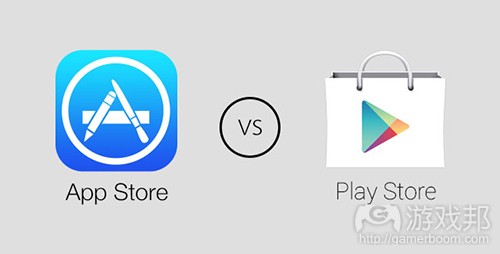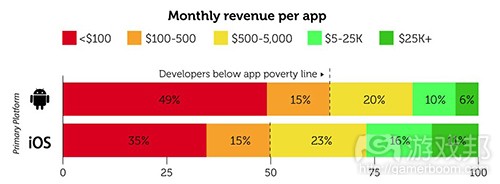每日观察:关注iOS和Android开发者收益调查等消息(7.12)
1)App Annie最新报告显示,Google Play下载量正在超越iOS App Store,但后者收益仍然更高。在上个季度,Google Play下载量比苹果多60%(前一个季度的这一比例为45%),但App Store收益仍然比Google Play多80%。
App Annie指出,中国正成为苹果国际化发展战略的重要枢纽,在2014年第二季度,苹果在中国收益将近100亿美元(包括零售销售额)。美国、中国和日本现在已经占据iOS半数以上的收益,而Google Play甚至还没有入驻中国市场。
日本已经成为iOS和Google Play手机游戏收益最高的市场,尽管Google Play在日本市场份额更大,但其收益仍然落后于iOS。
2)据pocketgamer报道,Gamevil日前宣布其智能手机下载量突破3亿次,目前公司总下载量已超过4亿次。
但值得注意的是,Gamevil下载数据显示其发展速度正在减缓,该公司在2012年3月实现1亿次下载量,但在9个半月后才再次实现2亿次下载量,在7个月后才实现3亿次下载量。
Gamevil历时将近12个月,才从3亿次下载量上升至4亿次下载量。
3)Developer Economics最新调查显示,有50%的iOS开发者和47%的Android开发者“生存在贫困线以下”,每款应用月收益不足500美元。
尽管游戏是目前最热门的应用类型,有半数应用下载量来自游戏,但仅有三分之一的开发者在制作游戏;有57%的游戏每月收益不足500美元。
88%开发者要分食仅占11%的应用收益,每月收益不足1万美元。另外9%开发者却吞食了35%的应用收益,每月收益介于1万至10万美元之间。最大赢家是那些仅占2%比例的开发者,瓜分了高达54%的应用收益,每月收益超过10万美元。
为解决盈利问题,许多游戏开发者采用了以量取胜的策略,发布多款应用。那些每月收益超过10万美元的大部分开发者最少发布了11款游戏,以便在应用商店获得更多机会。
报告指出,制作和营销多款应用可让开发者从这一过程中学到更多经验,并且也更可能实现盈利。
除此之外,那些瞄准企业用户而非消费者的开发者,每款应用收益超过5000美元的机率是一般开发者的两倍,每款应用月收益超过2.5万美元的机率也是后者的三倍。
有47%的iOS开发者并没有使用Objective-C这种本地语言开发应用,42%的Android开发者并不使用Java开发内容,这意味着他们可能是使用第三方工具,以HTML、CSS和Javascript等更简单的语言来创造应用。
4)据gamasutra报道,《战争机器》设计师Cliff Bleszinski新工作室Boss Key最近为亚洲MMO发行商Nexon所创造的新游戏是第一人称射击作品《BlueStreak》,他在日前采访中谈到自己之前的“隐退”行为时表示,没有新项目需要推广,没有日程安排的生活让他得以静下心来,退一步思考行业的走向。
他在2012年离开Epic Games,此后一段时间一直在思考自己的下一步行动。他希望为行业创造自己认为是新兴事物的游戏,并表示《BlueStreak》与自己观看足球赛的经历有关,但这并不意味着他打算制作体育类游戏,而是从粉丝忠诚度、团队品牌、球员魅力以及比赛规则等方面获得启发并创造游戏。
5)据venturebeat报道,针对许多家长投诉Google Play和iTunes误导子女偶然购买了《Farm Heroes Saga》等所谓“免费游戏”中的虚拟商品一事,欧盟最近要求苹果和谷歌两大巨头改变其销售此类游戏应用的方式,认为这些含有IAP的游戏实际上并非真正免费,因此不可以标榜为“免费游戏”。
谷歌已经响应欧盟的这个要求,将不再为Google Play中的此类游戏打上“免费”标签。
除此之外,欧盟还要求这两家公司不可再“直接游说”儿童购买IAP,必须提供完整的联系信息和明确的付费条款,谷歌已同意推出相应条款避免此类应用误导儿童在家长未许可的情况下消费。苹果虽然也同意解决这些问题,但目前尚未明确具体的执行计划。不过苹果已经推出了“极易使用”的家长控制设置,并且采取措施“明确标注”那些含IAP选项的游戏。值得注意的是,苹果还计划在iOS 8中新增一项“询问是否购买”的新功能,这将赋予家长更多控制子女可在App Store购买什么内容的权力。
6)据venturebeat报道,雅虎日前已收购移动分析公司Flurry,但并未透露具体成交金额,有媒体称这笔交易额超过3亿美元。
Flurry于2005年在旧金山成立,目前有超过17万名应用开发者在使用该服务,平均每台移动设备上就有7款应用安装了Flurry Analytics工具,有8000家发行商在用Flurry工具实现盈利。(本文为游戏邦/gamerboom.com编译,拒绝任何不保留版权的转载,如需转载请联系:游戏邦)
1)iOS still dominates Google Play for making money as China and Japan turn up the spending
Jeffrey Grubb
Google Play and iOS are both growing, but its Apple that still has it where it counts — the bottom line.
When it comes to the raw number of downloads on a platform, Google Play is outperforming the iOS App Store, according to industry-tracking firm App Annie, but Apple’s mobile system is still making more money. In the last quarter, Google Play had 60 percent more downloads than Apple’s market. That’s up from 45 percent more last quarter. That growing margin didn’t really help Google Play catch up on the revenue side of things. The App Store still made 80 percent more revenue than Google Play. The big reasons for this are China and Japan — although this doesn’t reflect the full story for Android. Mobile-game spending reached $16 billion in 2013, and it is on pace to bring in even more this year.
Earlier this year, Apple came to a deal with China Mobile that enabled iOS to start making significant revenue in the country. That explosive growth is tapering off, but Chinese iOS revenues still grew by 20 percent from Q1 to Q2. That massive market is expected to generate a large amount of mobile spending in 2014, and the iOS App Store is capturing a lot of that.
“China is proving to be pivotal in Apple’s international growth strategy,” reads App Annie’s report. “In its Q2 2014 earnings call, Apple reported a records high revenue in China of almost $10 billion, inclusive of retail sales.”
This this growth, the U.S., Japan, and China now represent more than half of all spending on iOS. The same isn’t true for Google Play. That store doesn’t have a presence in China. While Android is making a lot of money in the nation, these streams come through proprietary app stores from other providers.
Japan is already the top nation for mobile gaming in terms of spending on iOS and Google Play, and it is growing faster than ever thanks to a handful of new games. The top-performing Puzzle & Dragons continues to generate significant revenue in Japan, while fresh puzzlers Monster Strike and Disney Tsum Tsum grew the market even further.
While Japan has traditionally skewed toward Android, Apple is catching up after it made a deal to sell the iPhone directly through the country’s big service provider NTT Docomo earlier this year. That played a big part in boosting Apple’s smartphone sales in Japan by 50 percent year-over-year in Q2. That has helped iOS maintain its revenue lead even as Google Play captures larger market share.(source:venturebeat)
2)Gamevil: 400 million downloads and counting on smartphones
By Keith Andrew
Almost a year to the day after Gamevil announced it had hit 300 million downloads on smartphones, the Korean publisher has revealed total downloads have now passed 400 million.
The firm claimed recent releases such as Monster Warlord and Spirit Stones had “contributed to Gamevil’s growing fanbase and continue to drive up the number of Gamevil games on smartphones across the globe.”
Slowdown
However, the release of the figures suggests that the rate of growth is, in fact, tailing off.
Gamevil surpassed 100 million downloads back in March 2012, with the second 100 million coming in 9 and a half months flat. The 300 million milestone was then hit just 7 months later.
It’s taken Gamevil almost exactly 12 months, however, to jump from 300 million to 400 million downloads – almost twice as long as the gap between the two previous milestones.
Monster Warlord
Gamevil’s attention is now turning the to the launch of its new action RPG Kritika: Chaos Unleashed on iOS and Android, which it claims is “just the beginning of a series of highly-anticipated titles and updates being released this year.”(source:pocketgamer)
3)10,000-developer survey: 2% of coders split staggering 54% of all app revenue
John Koetsier
It’s a Darwinian world out there. And not many are winning.
A new 10,000-developer survey by Developer Economics says that 50 percent of iOS developers and 47 percent of Android developers are “below the app poverty line” and making less than $500 per app per month. That means “the majority of app businesses are not sustainable at current revenue levels,” Developer Economics says.
In addition, while games dominate the app stores, game developers are struggling. A third of developers are making games, which is low, considering that games are by far the most popular type of apps, and about half of all apps downloaded are games.
230 app developers with 9,000 apps and 397 million MAU
App stores are a classic winner-takes-all game, Developer Economics says.
88 percent of developers split just 11 percent of all app revenue and make under $10,000/month. Another nine percent split 35 percent of total app revenue, making between $10,000 and $100,000 per month. And the big winners with massive games, who make up just two percent of all developers, split a staggering 54 percent of all app revenue, making over $100,000 per month.
Most games — 57 percent of them — make less than $500/month.
To solve that revenue problem, many game developers release more than one app. In fact, the majority of those making over $100,000/month have published a minimum of 11 games in an effort to give themselves more chances at the app store lottery.
Building and marketing multiple apps helps developers learn from their mistakes, though, and that learning is critical, as developers who use third-party tools for development, for analysis, and for monetization are much more likely to make good money, according to the Developer Economics study.
In addition, developers who target enterprise, not consumers, are twice as likely to be earning over $5,000 per app and three times as likely to be earning over $25,000 per app per month.
One other interesting thing about iOS and Android developers: Big chunks of them are not using native languages to build their apps. In fact, 47 percent of iOS developers are not building in Objective-C, and 42 percent of Android developers are not building in Java, meaning that they’re likely using third-party development tools that allow them to create apps in simpler languages such as HTML, CSS, and Javascript. Those tools, of course, also enable cross-platform development without re-coding.(source:venturebeat)
4)Cliff Bleszinski opens up about the future of games
By Christian Nutt
“Not having an agenda has been tremendously freeing, creatively as well as professionally.”- Cliff Bleszinski on his “retirement.”
Gears of War designer Cliff Bleszinski has re-entered the game industry with BlueStreak, a free-to-play competitive first person shooter he’s developing for Asian MMO publisher Nexon at his new studio, Boss Key.
“Not having a project to promote, not having an agenda has allowed me to take a step back and look at where the industry is going more objectively,” Bleszinski says in a new interview with GamesBeat.
He intends to fundamentally change the way he made games in the Gears of War era, for one, he says. The announcement of the game was a surprise, but in comments he’s made publicly since then, Bleszinski’s thinking has crystallized.
Bleszinski left Epic Games in 2012 and has since spent his time away from the industry reading and contemplating his next move. He discussed his time away with Gamasutra earlier this year; now that he’s back, he’s sharing the observations he’s made.
“I used to be about flash, about making people cry, about hitting that musical crescendo and all that,” Bleszinski says. That has changed: “Now I’m all about systems interacting with systems… It goes back to the greatest games of all time, like chess and go — easy to learn, a lifetime to master. That’s the pinnacle of game design.”
He wants to create a game for the industry he sees emerging, not the one that has already passed. He borderline dismissive about Sony and Microsoft in the interview; his new game targets PC first and foremost.
The rise of eSports and a burgeoning interest in pro sports has also greatly influenced the direction he’s taking the game, he says: “I was watching the enthusiasm of the fans at the Evo championships in Las Vegas last week. That’s absolutely amazing. The reason why people want to get into it is this tribal nature.”
A lot about BlueStreak is “tied to things that I’ve learned from watching pro football, becoming a big fan of football on Sundays. This isn’t to say I’m going to make a sports game, but there’s so much to be learned from the fan loyalty, the branding of the teams, the player personalities, the broadcasting, the rules of the game.”
In the interview, he reiterated his desire to make a game that is accessible to all with an interest in the genre, yet allows pro players to showcase their skills at the highest levels — something he said in his Reddit IAmA.
That’s inspired by modern eSports, but also has its foundations in the old days of PC gaming, Bleszinski says.
“I used to go to some of the Quake tournaments in Dallas and other places, watching people like Fatal1ty playing professionally. They didn’t set out to make that at Id. They set out to make the most airtight multiplayer game possible, and then the community rallied behind it, and then it made that magical leap.”
His hope is to make a game that is just as “airtight.” To aid in doing so, he’s already scooped up a number of shooter veterans.
The full interview on GamesBeat has much more from Bleszinski, including his thoughts on free-to-play game design. It was published alongside an interview with Nexon president and CEO Owen Mahoney, who explains how he signed a deal with the prominent and (after his exit from Epic) much sought-after developer.(source:gamasutra)
5)Google & Apple: ‘If you charge for in-app goodies, you can no longer call your app free’
Brenda Barron
Looks like Google and Apple are finally responding to pressure around changing the way they deal with games that offer in-app purchases — thanks to some nudging from the European Commission, of course.
The EU asked both tech giants to change how they sell these game apps, specifically after receiving a ton of complaints from parents who likely had to pay hefty bills to Google Play and iTunes because their kids accidentally purchased all the things in Farm Heroes Saga. Or something like that.
One of the primary complaints was that games with in-app purchases shouldn’t be offered as “free” to download because they aren’t, in fact, really free. Google is already on top of this part of the EU’s requests. It will no longer label games with in-app purchases as free in the Google Play store.
The EU’s other requests involved not “directly exhorting” kids to make in-app purchases, providing complete contact information, and making payment arrangements completely clear. Google agreed to create guidelines for games that fall into this category so kids will no longer be encouraged to buy things without their parents’ permission.
Though Apple has agreed to address these issues, it hasn’t as of yet provided a timeline to do so. Previously, Apple was required to add alerts in iOS 7.1 that notify people prior to an in-app purchase. It was also forced to comply with an FCC order to refund $32.5 million to parents whose children made unauthorized in-app purchases.
Apple did offer a statement following the EU’s remarks indicating it has “incredibly easy to use” parental controls already in place. It’s also taken steps to make any game offering in-app purchases “clearly marked.” Apple also points out the Kids Section of the App Store has greater protections since the apps are created for those under 13 years of age in mind.
One interesting point is that Apple is planning on adding a new feature called “Ask to Buy” to iOS 8, which will give parents greater control over what their children can and cannot buy in the App Store.
It’s currently unclear if these new rules will apply to U.S. app stores, too.(source:venturebeat)
6)Late to the mobile game, Yahoo starts catching up with Flurry purchase
Richard Byrne Reilly
Google and Facebook account for two-thirds of the mobile ad spending tally worldwide, and by purchasing mobile analytic outfit Flurry today for a price that hasn’t been disclosed, Yahoo is hoping to level the playing field.
It will be a daunting task to catch up, but the Flurry acquisition finally shows that Yahoo is serious about becoming a “mobile first” operator, at least in the eyes of chief executive Marissa Mayer, whose tenure at Yahoo so far has been mixed.
Neither company has released the price. Press reports state the deal was in excess of $300 million. The San Francisco-based Flurry is one of the more successful mobile analytic players in the nascent mobile ad sector — which amounted to $17 billion last year and will crest $32 billion by the end of 2014, according to Gartner.
The deal, at least in the short term, makes sense to analysts.
“It does make sense because it gives Yahoo valuable insight into consumers app behaviors. It really gives them an understanding of how consumers use apps. It gives Yahoo consumer reach,” said eMarketer mobile analyst Cathy Boyle.
Boyle’s colleague, Andrew Marcec, agrees.
“Yahoo is really trying to grow their mobile business. What Yahoo has been saying, at least in their earnings report, is that revenue from mobile is growing,” Marcec said.
This from Flurry’s blog post announcing the deal:
“Today, Flurry is entering a new phase of its life. I am excited to announce that we have reached an agreement to be acquired by Yahoo and expect to be joining Yahoo very soon. Like us, Yahoo is committed to mobile and has become a mobile first company with over 450 million mobile MAUs, a number that has grown by 36 percent since last year. Yahoo is committed to being a part of consumers’ daily life on mobile.”
“Flurry’s success is the result of years of committed investment by a passionate team to create an indispensable platform for mobile developers. We want to harness our collective innovative spirit and bolster the mobile ecosystem by providing developers the analytics and monetization solutions to drive their success,” said Scott Burke, Yahoo’s senior veep for ad technology, in a release trumpeting the deal.
Flurry started in San Francisco in 2005, and it has grown into one of the most-important companies in app advertising and analytics. The technology firm has established an especially strong connection with game developers. Those companies use Flurry to maximize revenue from the revenue that they make from their games.
More than 170,000 app developers use Flurry, and the tech firm’s SDK tracks more than 150 billion sessions every month. For Yahoo, Flurry would give them an instant relationship with a huge number of the people and companies responsible for the mobile-app economy.
Flurry has raised a total of $74 million in funding since it was founded.
Yahoo has not said what exactly the company is pulling in from their mobile endeavors. There have been vague assertions that Yahoo’s mobile search offerings grew 100 percent year over year and that half the company’s 500 million users are logging in with mobile devices. But it hasn’t released any hard mobile numbers.
At least for now.
Flurry has proven a useful conduit for companies launching advertising campaigns in the mobile arena. A few of their numbers released today show that Flurry sees app activity from 1.4 billion devices monthly; sees 5.5 billion app sessions per day; Flurry Analytics is in 7 apps per device on average; and that 8,000 publishers monetize with Flurry.
So, yes, incorporating Flurry’s knowledge base into Yahoo’s mobile strategy is a good start. But Yahoo will likely take a year or more to get its mobile game to the level of Google, Facebook, and even Twitter — if ever.
“It’s a smart way to go for Yahoo, a step in the right direction, but they still have a long way to go,” Boyle said.(source:venturebeat)













































 闽公网安备35020302001549号
闽公网安备35020302001549号